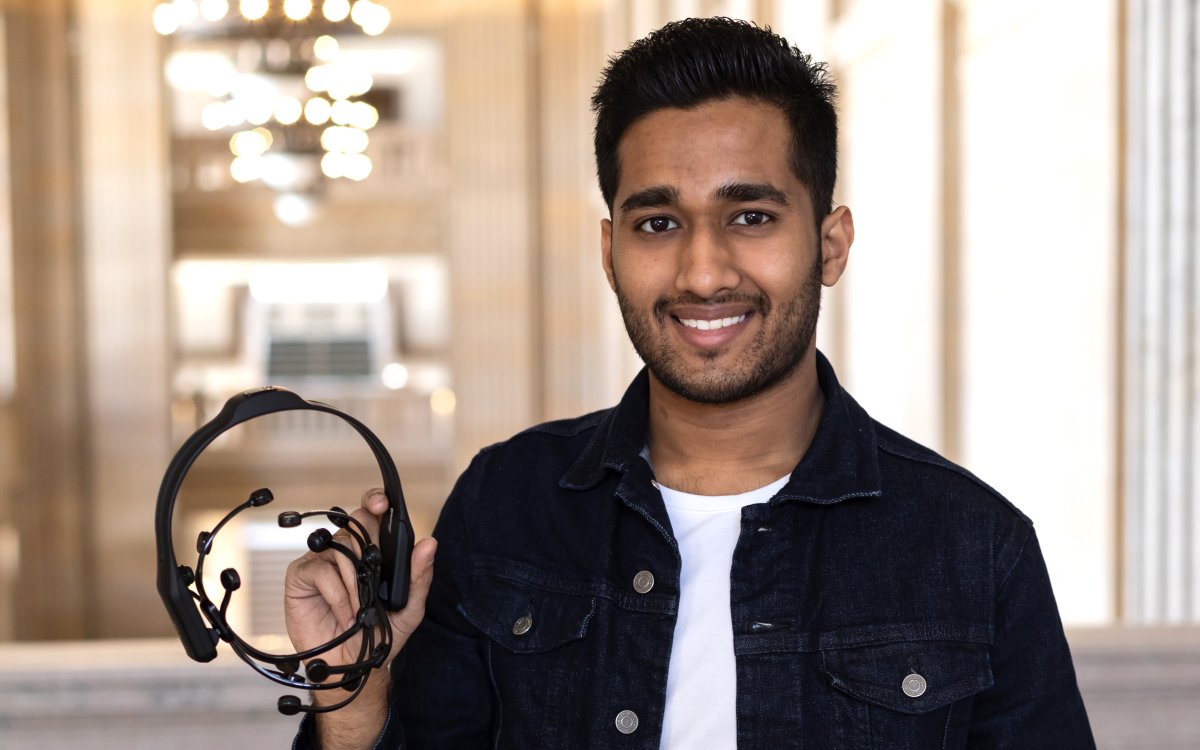Prototype to market

Above: Stephen Mylabathula (Computer Engineering ’19) hopes to provide greater wheelchair mobility through head movement and brain signals for quadriplegics and those with spinal cord injuries.
Credit: Rebecca Slater/By Rebecca Studios
CSE graduate brings classroom lessons to his startup and invention for wheelchair users
July 5, 2019
Stephen Mylabathula, who graduated this May with a computer engineering degree, had good reason to take Kirk Froggatt’s “Leading Breakthrough Technology Innovation” class.
The class—taught by Froggatt, the University of Minnesota College of Science and Engineering’s Gemini Chair in Technology Management—teaches future STEM leaders to bring ideas to market.
Mylabathula and friends had recently invented a headband controller that a quadriplegic might use to guide a wheelchair through head movements and brain signals, instead of cumbersome blowing devices or chin-controlled joysticks. It was time to learn how to get the prototype to market.
“Innovation really happens at the intersection not only of technical feasibility but also market viability and customer desirability. That’s really what I learned in Kirk’s course,” Mylabathula said, when asked to spell out his key takeaway.
Another valuable concept was “platform architecting”—brainstorming several applications that might spring from a single technology development. If one area doesn’t pan out, for technical or economic reasons, innovators can turn to another. Or one commercial development can piggyback on another.
“Now all of a sudden, you’re milking every last penny out,” Mylabathula said.
“By taking the time to look at short-term, mid-term, and longterm applications of this one piece of technology, you’re able to get so much more value out of every small R&D advance that you have,” he added.
Mylabathula, a recipient of multiple College of Science and Engineering scholarships including the Roger Nordby Electrical Engineering Scholarship and the Hopper-Dean Scholarship Honoring Dr. Vipin Kumar, wants to bring those lessons to his new company, Galilea Technologies—the name is based on the scientist Galileo, but also Galilee, a Biblical name with connotations of walking on water.
“We’re bringing back natural mobility, a new way of transportation and mobility for wheelchair users,” he said. “So maybe if it’s not as cool as walking on water, for these people it might be that big of a change for them.”

The wheelchair project began in 2016 at the Massachusetts Institute of Technology International Hackathon. Mylabathula was teamed with “three random guys” who got their pick of materials to cobble together an invention and pitch it to a panel of judges. They grabbed a $200 Muse headband—a device marketed to enhance meditation that detects head movements and electrical brain signals—and they used it to control a small robotic car.
But they pitched their idea as a prototype of a wheelchair controller. The team placed in the top 10 of more than 250 competitors.
“I was really excited,” Mylabathula said. “But what I failed to recognize for almost six months was that this idea could actually be useful for people.”
Nevertheless, he brought the idea back to the University of Minnesota and his friend Furqan Syed, a senior majoring in computer science. The pair refined the headband for wheelchair users. In 2017, they won first place in the University’s BizPitch student entrepreneur competition, earning $1,000 to invest in their creation.
Since then, Mylabathula and Syed have built the prototype with an actual wheelchair that they tested out with 13 users last semester. This spring, they held a successful “demo day” with help from Gillette Children’s Specialty Healthcare and the U.S. Department of Veterans Affairs.
Mylabathula said the lessons from Froggatt’s class are paying off.
“What platform architecting taught us is we can go into a lot of different markets,” he explained. “If one market doesn’t work, we’ll quickly pivot into a different market.”
The class also led to a summer internship at Oculus, the Facebook-owned virtual reality company.
“I made an impact simply because I didn’t look at something as just a technical project,” Mylabathula said. “You want to develop both your depth and your breadth—like the letter T right? Today’s industry really wants people who have a lot of depth in their field, but also can communicate with other teams, can explain things in more natural and easy-to-understand methods, and really be that T-shaped person.”
Story by Greg Breining
Read about two other students who took Froggatt’s “Leading Breakthrough Technology Innovation” course:
Lucas Abbott: Test prep to health care
Ashtynn Trauth: The right pitch
If you’d like to support experiential learning and student scholarships at the University of Minnesota College of Science and Engineering, visit our CSE Giving website.
